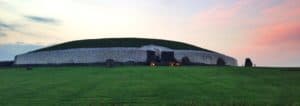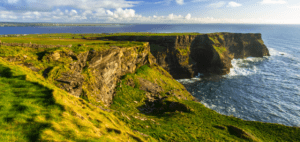New Zealand’s Kauri Forests: A Guide to the Majestic Woodland Giants
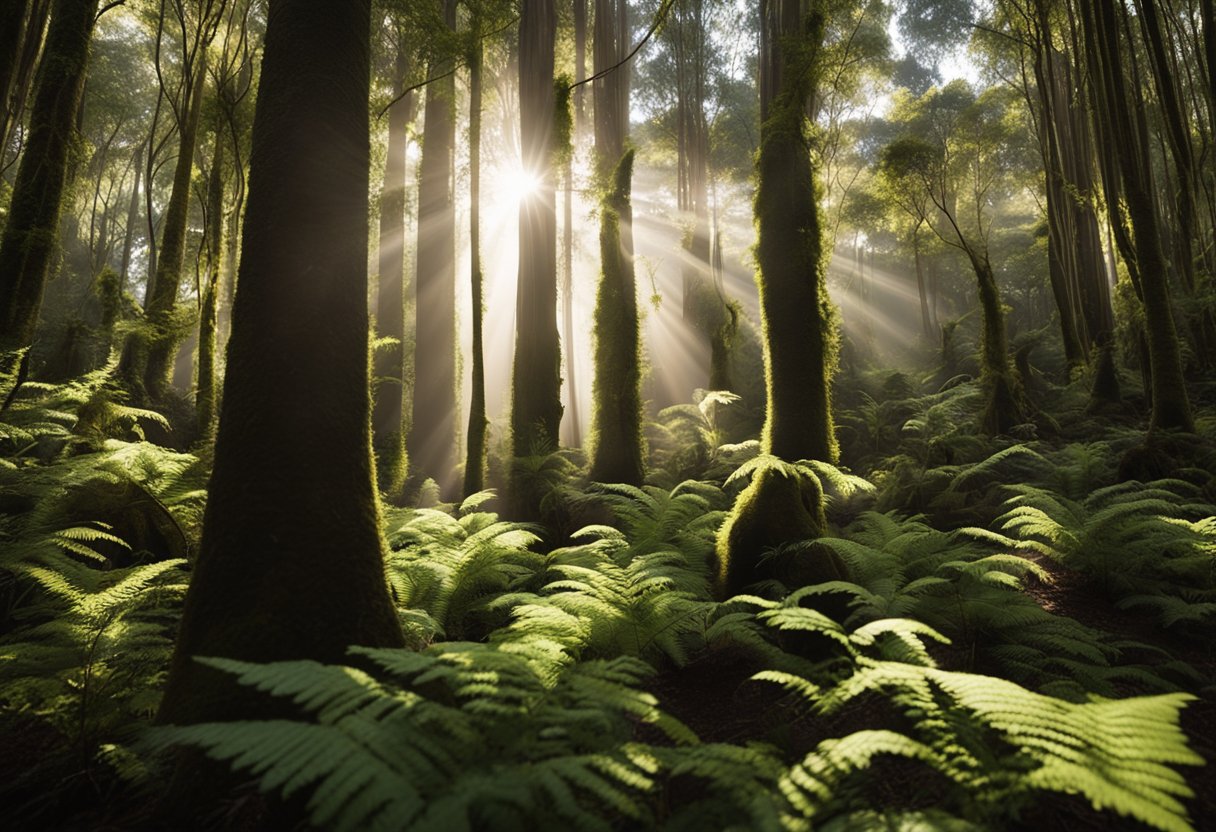
Updated On: April 04, 2024 by Raghda Elsabbagh
New Zealand’s Kauri forests stand as sentinels of time, with their colossal trunks and towering canopies dominating the landscapes of the North Island. These ancient giants, with their broad, buttressed bases and smooth, scalloped bark, have fascinated and inspired generations. Known as Tāne Mahuta in Māori myth, which means “Lord of the Forest,” the largest Kauri tree symbolises the significance and spiritual resonance these trees hold in New Zealand culture.
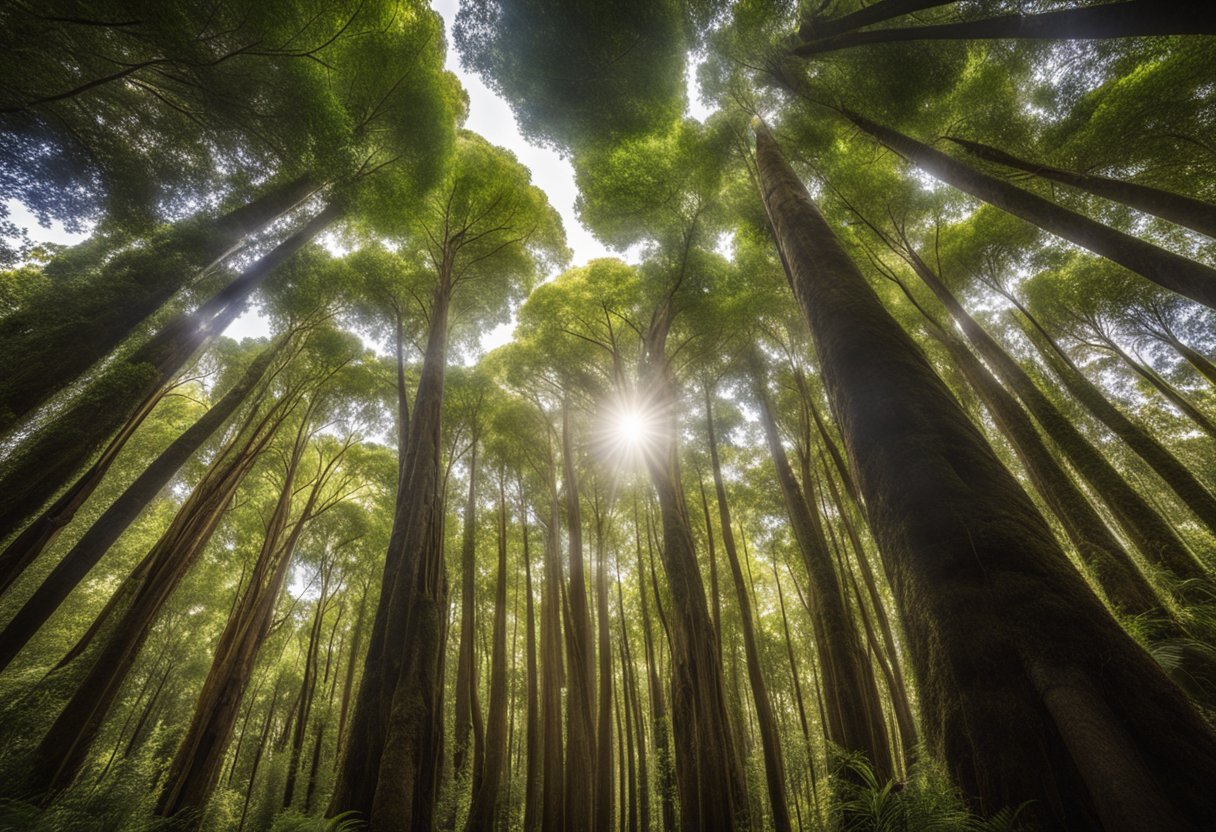
Kauri trees are not only celebrated for their imposing presence but also for their substantial role within the ecosystems they dominate. These forests are unique biodiversity hotspots, providing habitat for a plethora of native flora and fauna. They are at the very heart of New Zealand’s ecological identity, interwoven with the country’s natural and cultural heritage. However, despite their importance, Kauri forests face a number of threats that challenge their survival and necessitate urgent conservation efforts.
Table of Contents
The Kauri Tree: An Overview
In this section, we explore the remarkable Kauri tree, renowned for its towering presence in New Zealand’s forests, its rich history intertwined with human culture, and its deep significance to the Maori people.
Biological Characteristics
The Kauri tree, or Agathis australis, is a majestic evergreen endemic to New Zealand, recognised for its massive size and longevity. These ancient giants can reach heights of over 50 metres and boast trunk girths that expand up to 16 metres. Kauri trees are not only awe-inspiring in stature but are also known for their smooth bark and small, leathery leaves.
Historical Significance
Historically, the lifespan of these trees can extend over 2,000 years, making them a living chronicle of New Zealand’s natural history. Once, Kauri forests covered 1.2 million hectares, forming a dominant canopy across the upper North Island. Extensive logging, particularly during the 19th and early 20th centuries, significantly reduced their population, framing a narrative of both human marvel and ecological caution.
Cultural Importance
For the Maori, the native people of New Zealand, Kauri trees hold substantial cultural importance. The trees provided various materials, from the medicinal properties of the gum to the exceptional timber used in creating waka (canoes) and other significant artifacts. As symbols of strength and endurance, Kauri trees are often featured in Maori mythology and are revered as taonga (treasures).
Through respect for their ecological, historical, and cultural significance, we gain a deeper appreciation for the Kauri, and the need for their preservation becomes ever more clear.
Geographical Distribution
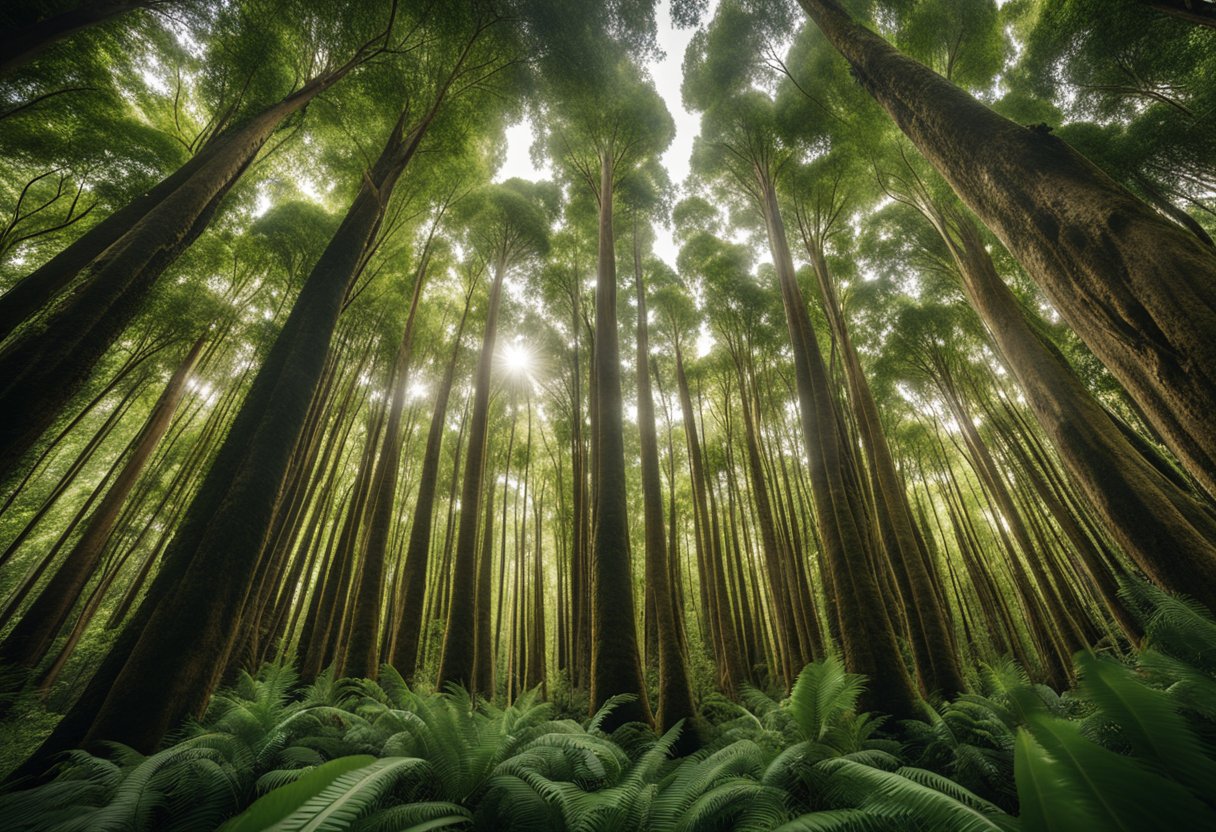
We’ll now explore the regions where the ancient Kauri trees have firmly rooted themselves into New Zealand’s landscape. These towering trees predominantly grace the upper reaches of the North Island, providing a natural record of the land’s history.
Northland’s Forests
In Northland, the Kauri forests are an iconic aspect of the region’s natural heritage. They can principally be found throughout the Waipoua Forest, which is home to the famous Tāne Mahuta, the largest living Kauri tree known today. These forests extend across the wider Northland region, making it a significant hub for Kauri distribution on the North Island.
Coromandel and Other Regions
Beyond Northland, the Coromandel Peninsula also hosts these majestic trees, with forests that dot the landscape, adding to the region’s rugged beauty. Notably, the Kauri can also be found sprinkled across areas like the Great Barrier Island, though in much lesser densities than the larger tracts of forest in the previously mentioned areas. These trees have historically spread their canopies far and wide across the North Island, dominating the skyline and creating ecosystems rich in biodiversity.
Ecosystem and Biodiversity in New Zealand’s Kauri Forests
Within the majestic New Zealand’s Kauri forests, a complex ecosystem thrives. This ecosystem is a tapestry woven from diverse flora and fauna, each species playing a pivotal role. Our journey delves specifically into the interactions within this ecosystem and the significant part the Kauri trees hold in the forest’s hierarchy.
Flora and Fauna Interactions
The Kauri forests are a hub of biological interactions where native birds, like the Tui, contribute to the pollination of various plant species. These avian residents also assist in seed dispersal, which is crucial for forest regeneration. The North Island Brown Kiwi, another integral species, forages on the forest floor, affecting the soil composition and invertebrate populations. Together, these fauna and the rich flora create a dynamic equilibrium, each dependent on the other for survival and flourishing biodiversity.
Kauri’s Role in the Forest
The Kauri tree is undeniably the forest’s cornerstone, often described as the “Forest giants”. These trees not only provide a canopy that regulates the forest microclimate but also enrich the soil through their leaf litter. Their massive root systems create a unique subterranean environment that supports a myriad of organisms, further influencing the forest’s overall ecosystem. Thus, the Kauri hold a monumental place, physically and ecologically, within the forest structure.
By understanding the significance of each organism within these forests, including the majestic Kauri, we gain insights into the intricate balance of life-sustaining New Zealand’s unique woodland realms.
Conservation Efforts

In facing the threats to our kauri forests, we’ve seen significant conservation efforts focusing specifically on combating kauri dieback and tightening protection and regulations to ensure the survival of these giants.
Dieback Disease
Kauri dieback, caused by the pathogen Phytophthora agathidicida, poses a severe threat to our treasured kauri trees. This disease leads to a state where the trees are unable to transport nutrients and water, effectively starving the kauri. In response, there has been a collaborative effort involving research, public education, and the implementation of sanitising stations at forest entry points. These measures are crucial for preventing the spread of the microscopic spores that cause this devastating disease.
Protection and Regulation
The Department of Conservation has been at the forefront of the battle, introducing strict regulations to protect these ancient giants. This includes restrictions on human access to certain forest areas that are critical habitats for kauri trees. For example, parts of the Waitākere Ranges were temporarily closed to the public to prevent the further spread of kauri dieback. Moreover, the department actively manages soil disturbances and advocates for controlled forest visits, working tirelessly to balance public interest with the well-being of these forests. Conservation of the kauri is not just about regulations; it is about appreciating and valuing an integral part of our natural heritage.
The Kauri Industry: Past and Present
In New Zealand, the kauri forests have been both a natural wonder and a significant source of timber and gum throughout history. Today, we witness a transformed industry, carefully balancing conservation efforts with sustainable use and trade.
Historical Logging
Logging played a pivotal role in the history of New Zealand’s northern regions. Initially, Kauri timber was prized for its exceptional quality, contributing substantially to the exports of the fledgling colonial economy. The timber industry peaked in the late 19th and early 20th centuries, with vast tracts of old-growth forests harvested for local use and international trade. Beyond timber, kauri gum, a resin exuded by the trees, also became highly valuable. This fossilised sap was extensively collected and exported to produce varnish and paint, crucial to industries overseas.
Contemporary Uses and Exports
In stark contrast, the present-day kauri industry is defined by strict environmental regulations to ensure the survival of remaining forests. Exports of kauri timber are minimal, often restricted to salvaged logs or those from sustainable sources. Kauri wood continues to be used in specialist applications, such as boat building and custom furniture, where its durability and fine grain are highly revered. The legacy of the once-flourishing kauri gum trade can be seen in the few remaining artisanal products made from the gum, reflecting a deep respect for this unique natural resource.
Indigenous Knowledge and the Kauri
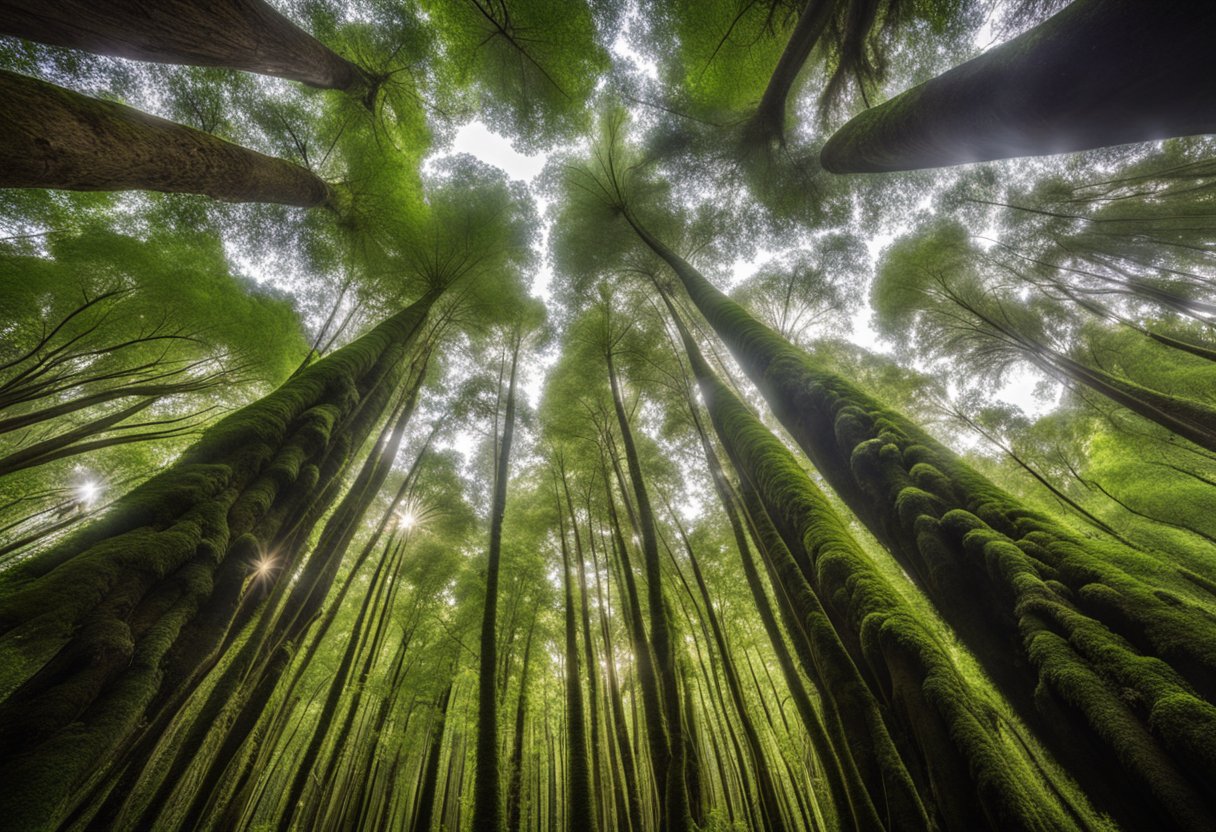
The Kauri trees of Aotearoa have long known the touch of Māori hands and the whisper of their lore. Our exploration of the Kauri forests is incomplete without the indigenous wisdom that threads through their history.
Māori Perspectives
The Māori view the Kauri (Agathis australis) as taonga, treasured entities deeply rooted in their culture and cosmology. These giants of the land are considered ancestors by some iwi, embodying the vital connection between the heavens and the earth. The spiritual and practical wisdom of the Māori has been passed down through generations, guiding the guardianship of these ancient sentinels. Management strategies for Kauri dieback reflect this ethos, emphasising the need to protect the trees from ecological threats.
Reverence for Kauri is also portrayed in traditional carvings, where the durable, fine-grained timber was used to craft waka (canoes) and wharenui (meeting houses), linking artistry with functionality. These carvings are not mere decorations but narratives in wood, telling tales of ancestry, values, and the interwoven life of people and forests.
Traditional Use and Significance
Long before the signing of the Treaty of Waitangi, the Kauri held significant worth in the lives of Māori communities. The tree’s gum was utilised in myriad ways, from making jewellery to sealing waka. Our context of Kauri cannot overlook the importance of traditional ecological knowledge and indigenous practices like kaitiakitanga, denoting environmental stewardship.
This indigenous knowledge persists, reminding us of the profound bond between the Māori and the Kauri, a bond that extends far beyond utilitarian use to embrace the Kauri as kin and protector—a status underscoring an ethos of respect and conservation for our shared environment.
Threats to the Kauri Forests
The mighty Kauri forests are an iconic part of New Zealand’s natural heritage, but they face serious threats from both environmental factors and human impacts that threaten their survival.
Environmental Factors
The most pressing environmental threat to kauri forests is the Phytophthora agathidicida, a fungus-like pathogen that causes kauri dieback disease. This disease leads to the rotting of the trees’ roots, effectively choking off the nutrients and water vital to their survival. The climate also plays a role in the forests’ health; changing weather patterns can stress the ecosystems the kauri trees depend on, potentially making them more susceptible to disease and pests.
Human Impacts
Historically, logging severely reduced kauri populations, as these giants were felled for their valuable timber. While large-scale logging is no longer a threat, the remnants of these practices still echo in the diminished genetic diversity and reduced population numbers of kauri forests. Additionally, human movement through kauri stands can spread kauri dieback spores, further exacerbating the situation for these already vulnerable trees. Moreover, even as conservation efforts increase, balancing human interaction with these giants remains a delicate and ongoing challenge.
Kauri in Science and Education
In this section, we explore the significant contributions of Kauri trees in the scientific and educational realms, as well as the ongoing efforts to understand and protect these giants.
Research on Kauri Ecology
Extensive research on Kauri ecology sheds light on their crucial role in New Zealand’s ecosystem. Scientists study these trees to understand their growth patterns, longevity, and resistance to environmental changes. The Department of Conservation (DOC) is actively involved in researching Kauri, particularly concerning the spread of Kauri dieback, a deadly disease caused by the pathogen Phytophthora agathidicida. Efforts to find a cure and management strategies are a high priority, as this disease poses a significant threat to Kauri populations, including the iconic Tāne Mahuta, known as one of the largest living Kauri trees.
Researchers also collaborate with the Ministry for Primary Industries to study the impacts of environmental factors and human activities on the health of Kauri forests. This collaborative approach is vital for developing conservation strategies and understanding the broader implications of forest ecosystems on New Zealand’s biodiversity.
Educational Initiatives
Our educational initiatives regarding the Kauri encompass a range of programmes designed to raise awareness and actively involve the community in conservation. Schools and educational institutions frequently conduct field trips to Kauri forests, enabling students to observe these majestic trees first-hand. Interactive sessions and resources developed in conjunction with the DOC and local iwi (tribes) inform about Kauri ecology, the significance of Kauri in Māori culture, and the critical situation surrounding Kauri dieback.
Moreover, various outreach programmes encourage citizens to get involved in protecting the Kauri. These programmes include planting native species that support the health of Kauri ecosystems and adhering to hygiene protocols to prevent the spread of Kauri dieback. Through these initiatives, we aim to cultivate a generation that not only appreciates the grandeur of Kauri trees but is also equipped to protect them for future generations.
Tourism and the Kauri
Our journey takes us to the majestic New Zealand’s Kauri forests, which are natural wonders that serve as pillars of ecological importance and cultural heritage. The draw of these ancient giants is undeniable, fostering a thriving tourism sector centred around sustainability and nature appreciation.
Eco-Tourism
In the realm of Eco-Tourism, the Kauri forests hold a special place. Our travels through these living sanctuaries are a harmonious blend of nature and careful stewardship. Visitors can experience the breathtaking beauty of the forests while following strict “Kauri dieback” prevention measures to protect these precious trees from soil-borne pathogens. One highlight is the Waipoua Forest, a primaeval woodland home to the largest known kauri tree, Tane Mahuta. This ‘Lord of the Forest’ is not only a natural spectacle but also a spiritual emblem to the Māori people. Eco-tourism initiatives ensure that we engage with these environments mindfully, preserving them for generations to come.
Kauri Attractions
Kauri Attractions blend historical insight with natural splendour. Footprints Waipoua offers guided walks enabling us to traverse nocturnal paths and discover the venerable trees under the starlit sky. Through storytelling, song, and reverence, we gain a profound connection to the Kauri and Māori cultures. In Matakohe, the award-winning Kauri Museum tells the tale of the region’s pioneering past. Artefacts, photographs, and kauri timber showcases provide us with an informative backdrop against which the importance of these trees to New Zealand’s history is vividly portrayed. Our visit to these sites, therefore, becomes more than a tourist activity; it is an educational pilgrimage that honours the legacy of Kauri in Aotearoa.
Cultural Representations
In New Zealand, the Kauri forests are not just natural marvels but also a canvas for cultural representations, reflecting the deep connections between the land and its people, especially among Maori communities.
Kauri in Art and Literature
We find that Kauri trees have been a potent source of inspiration in New Zealand’s art and literature, with their grandeur and longevity symbolising strength and resilience. In Maori artwork, Kauri often features as motifs that represent the connection to Te Ao Māori – the Maori world. They have been depicted in various forms, from detailed carvings in Marae (meeting houses) to contemporary artworks that resonate with themes of heritage and identity.
Symbols and Metaphors
For the Maori, Kauri trees are intertwined with symbolic meanings and serve as metaphors for leadership and ancestry. Conservation groups frequently collaborate with Maori communities, especially in regions like the Bay of Islands and Nelson, to preserve these sacred giants. Through the joint efforts in these regions, the Kauri tree becomes more than just a silent spectre of the forest; it is a living symbol of cultural continuity and environmental stewardship.
Future of the Kauri Forests
In facing the challenges ahead, the future of New Zealand’s kauri forests hinges on the success of restoration projects and the implementation of sustainable practices.
Restoration Projects
We are witnessing a significant push towards the propagation of seedlings to ensure the survival of kauri forests. Through conservation efforts, groups in New Zealand have been actively growing kauri from seeds in protected nurseries with the aim of reintroducing them into the wild. Additionally, the integration of kauri grass, known for its ability to grow in harmony with these trees, is aiding in the regeneration of the ecosystem.
Sustainable Practices
Our focus on protection extends to adopting sustainable practices that minimise human impact. Rigorous cleaning stations are in place to prevent the spread of soil-borne pathogens, while controlling access to certain areas ensures that the delicate root systems of kauri are undisturbed. By championing these methods, we contribute to the stewardship of these forest giants and the diverse biosphere they support. The impact of such efforts has been evidenced in the Waitākere Ranges, showcasing a shift towards a more hopeful future for these ancient sentinels.
Frequently Asked Questions
In this section, we answer your most pressing questions about New Zealand’s magnificent Kauri forests, shedding light on their current challenges and the efforts being taken to safeguard these natural giants.
What factors are contributing to the decline in Kauri tree populations?
The majestic Kauri trees are facing threats from a few fronts, including Kauri dieback disease, a soil-borne pathogen that attacks and kills the trees. Human activities like forestry and land development have also led to habitat loss, further exacerbating the decline.
How does the Kauri dieback disease affect New Zealand’s forests?
Kauri dieback disease, caused by the pathogen Phytophthora agathidicida, leads to a reduction in Kauri populations, jeopardising the forest’s ecological balance. Infected trees exhibit canopy thinning, yellowing leaves, and lesions that bleed resin, ultimately resulting in the tree’s death.
In what ways are conservation efforts attempting to protect Kauri trees?
Conservation initiatives involve enhancing biosecurity measures to prevent the spread of Kauri dieback, researching resistant Kauri strains, conducting public education campaigns, and enforcing access restrictions in affected areas to reduce the risk of pathogen transmission.
Which conservation areas can one visit to see the Kauri trees in their natural habitat?
Visitors can witness the grandeur of Kauri trees in several protected areas, such as Waipoua Forest, home to the famous Tane Mahuta, and the Coromandel Peninsula, which offers walks through impressive stands of these ancient trees.
What ecological role do Kauri forests play in New Zealand’s environment?
Kauri forests act as critical ecosystems supporting a diverse range of flora and fauna. They play a vital part in soil stabilisation, water regulation, and carbon storage, besides being integral to the cultural identity and heritage of the Maori people.
To what extent is climate change impacting the Kauri forests?
Climate change poses a significant threat, potentially amplifying the impacts of Kauri dieback disease and altering the delicate microclimates in which Kauri forests thrive in. Increased temperatures and changes in rainfall patterns can affect the growth and health of these trees.




